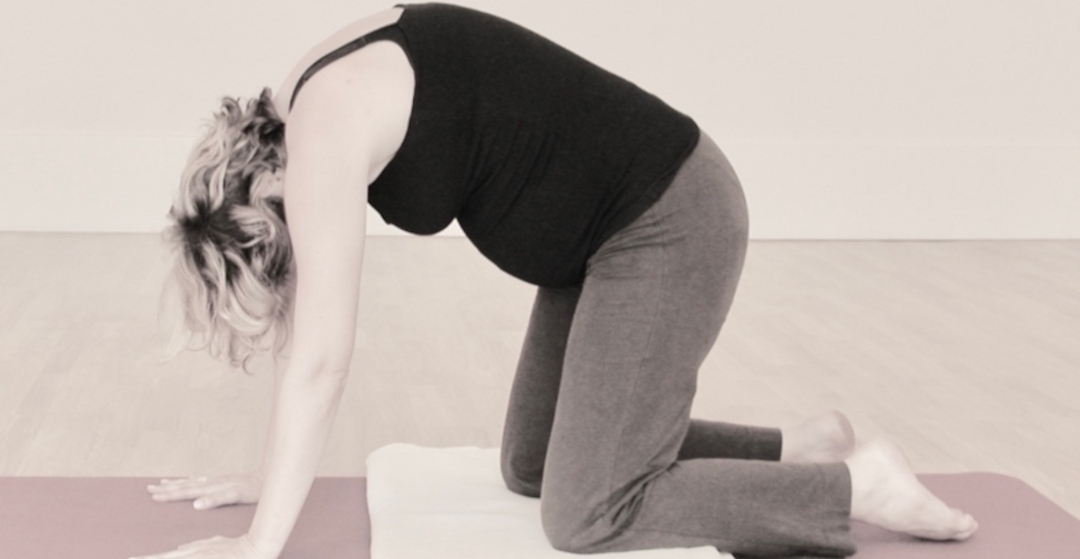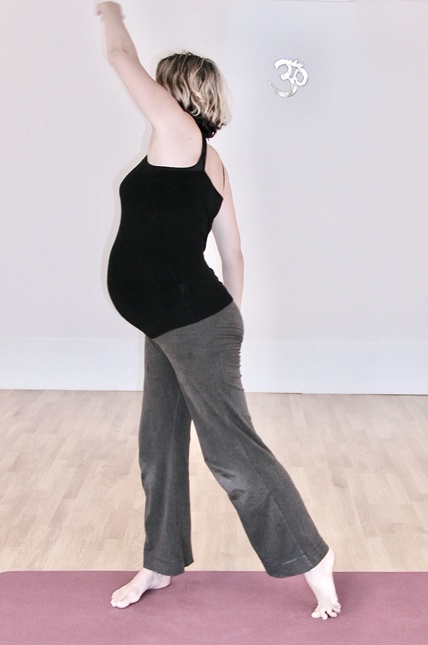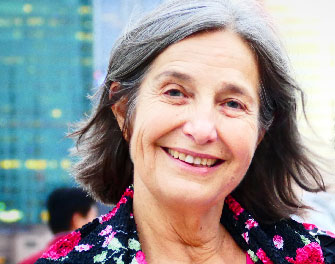
From the start of Birthlight classes, the changing bodies of pregnant women who were mostly new to yoga called for a dynamic approach to stretching to make space for the growing babies inside. We used the breath, mostly the exhalation, to extend the muscles below, above and to the sides of the expanding uterus. We used fluid movements to avoid static held poses and their adaptations with props. We found micro-movements that helped to stretch hidden small muscles often not reached in regular yoga practice, particularly in the pelvis. By relaxed stretching, we meant going all the way to find the full extension of muscles without tensing (now we know that fascia tissues are also involved) and then to enjoy their full relaxation.

I, Françoise, learnt the experience of relaxed stretching from BKS Iyengar in London in the late 1970s. I can still hear him say: ‘tip of your middle fingers’. It changed my standing poses. I also remember watching him demonstrate Uttanasana, extending his crossed arms to the floor and then slowly further and further without apparent effort or tension. It was magical. From that day I started studying the anatomy of T12/L1-2, not just because I held tension there in my body but also because I felt this area where the thoracic diaphragm links up with the lumbar spine and the pelvis, was key to yoga asanas in the various planes.
We, Birthlight tutors and teachers, have conveyed the experience of relaxed stretching as interoception for many years with a simple practice of calm breathing in an aligned sitting position, with one raised arm held relaxed by someone standing behind the practising person. Without ‘doing’ anything else than breathing, the raised arm starts extending upwards on exhalations. The supporting person watches it happen and feels it. The sitting practitioner often experiences warmth, overall relaxation in the body and at times a feeling of peace and wellbeing from the spontaneous engagement of the parasympathetic mode of the nervous system. Long before the use of terms like ‘somatic yoga’ or ‘embodied’ yoga’, with this simple practice (as well as with various ‘grounding’ and earthing’ practices), we invited students to explore sensations and perceptions so that they could discover how to relate to gravity through the actions of the breath at a deeper level in their bodies. The teachings of Vanda Scaravelli supported this exploration.
Stretching has now a bad name in some yoga circles. Quite rightly so when it is done from the outside-in. But when it’s done from the inside-out, stretching is infinite and extends to all the five Koshas. Each person, each body, in their present life-phase, range of motion and flexibility (or lack of it) can discover the wonder of relaxed stretching – with the breath.

Stretching done in a relaxed way in the Birthlight yoga repertoire for pregnant women, new mothers and women wishing to focus on their feminine wellbeing is typically slow, done to the rhythm of one’s own breath -that lengthens in the process. Following Patanjali’s sutras, the activity needs to be comfortable and effortless in a steady position. We watch the facial muscles for hints of possible tension. Achievers are invited to explore thresholds, when pushing beyond the boundaries of one’s current range of motion is done with willpower/ego rather than allowing the body to yield in the extension. We do not have rules about holding: if the pose is comfortable and enjoyable and the breath is productive, why not hold it? This corresponds to the traditional teaching of yoga. If there is discomfort, flow and rhythm can be invited to ease the practice. The distinction currently made between static and dynamic forms of stretching melts in practice. Some of the birthlight hallmark practices, like ‘rolling cat’, are based on flow to avoid drawbacks of specific ‘held poses’: in the case of pregnant women or menopausal women, cow pose tends to aggravate a lumbar dip which can weaken the lower back rather than strengthen it. For women who do not have lumbar issues, the held ‘cat/cow’ practice may be perfect. Dynamic stretching, now included in warm up routines before sport activities, has been shown to reduce muscle strains, (but not to significantly prevent injuries), and to improve performance more than static stretching.1 Held stretches for more than 90 seconds, however, whether performed actively or passively with the help of straps, walls or another person, are now considered to be effective to help ‘repatterning’ the fascia collagen-rich tissues which may determine our body structure as they encase muscles.2
We do not pretend to have done it all before fancy new techniques and styles of exercising came into being. Yoga is so inclusive and wide-ranging in its resources and applications that we can keep drawing deep from its well of knowledge, both for practice and philosophy.

PNF (Proprioceptive Neuromuscular Facilitation) is an interesting concept because it fits well with our birthlight explorations around the pelvic muscles that support the female reproductive organs. Starting from Mula Bandha, we have designed ways of squeezing/tightening pelvic floor muscles singly or in opposition to one another, then relaxing fully to elongate, resulting in elasticity rather than mere toning. PNF focuses on the process of muscle squeezing to go further into a static stretch3. It is popular with physiotherapists because it is progressive, allowing a muscle to adapt to its new position each time it is held in position. Integrated within yoga, rather than taking a biomechanical approach to stretching, we see each muscle as connected with ALL the other muscles in the body through fascia lines.4 Stretching one set of muscles with breath awareness will inevitably lead to others, usually just those which the person needs to attend to at the time, resulting in an expansion of consciousness and wellbeing beyond improved flexibility and strength.
There are many entries on ‘relaxing stretch/yoga’ on the internet, with most practitioners advocating Yin Yoga or related practices. The focus is on stress release and/or workout for stiff muscles with some mentions of mindful breathing. We can keep referring to relaxed stretching as briefly presented above: a mode of gaining muscle elasticity with proprioception through the action of the breath as a bridge to the parasympathetic mode of the nervous system.
To conclude, whether static or dynamic, we need stretching to transform our relation to gravity that defines us as modern hominids, as our bodies change in time and age. Relaxed stretching is a conscious practice that involves our breath and nervous system and allows us to inhabit our bodies more fully. Our global culture places a high value on muscle tone but adverse effects of a sedentary lifestyle are widespread. Dynamic stretching and high muscle performance are pleasing, even addictive, but over-toning can be detrimental to long-term health and wellbeing. In yoga as breath and movement combined, reaching out to the deep muscles, both voluntary and involuntary, that house the central nervous system is an ancient and safe way to access the source of overall balance and joy of being.

Françoise Freedman
Birthlight Tutor & Founder
Dr Françoise Freedman is the Founder and Director of Birthlight. She is a pioneer, Senior Yoga Teacher, acclaimed writer and lecturer of Social Anthropology at the University of Cambridge.
1 Opplert. J and N. Babault. 2017. Acute effects of dynamic stretching on muscle flexibility and performance: an analysis of the current literature’. Sports Medicine Vol 48(2):299-325.
2Findley T, Chaudhry H, Stecco A, Roman M. Fascia research–a narrative review. J Bodywork Movement Therapy. 2012 Jan;16(1):67-75
3 Hindle KB, Whitcomb TJ, Briggs WO, Hong J. Proprioceptive Neuromuscular Facilitation (PNF): Its Mechanisms and Effects on Range of Motion and Muscular Function. J Hum Kinet. 2012,Mar;31:105-13. doi: 10.2478/v10078-012-0011-y. Epub 2012 Apr 3. PMID: 23487249; PMCID: PMC3588663.
4 https://fasciaguide.com/experts/robert-schleip/
Copyright: Françoise Freedman & Birthlight